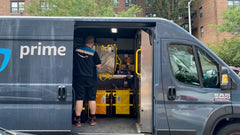
Transforming Marketing: 7 High-Leverage AI Strategies for Modern Brands
Table of Contents
- Key Highlights:
- Introduction
- Automated Product Intelligence: Every Hour, Every Market
- Dynamic Brand Voice Engines for Customer Reviews
- Hyperlocal Trend Forecasting Using Cross-Platform AI Listening
- Visual Merchandising Audits Without Stepping Foot Inside
- Competitive Positioning Intelligence on Autopilot
- Real-Time Voice of Customer Feedback Loop
- AI-Driven Operational Workflow Triggers
- How to Begin (Strategically) With AI
- What This Means Going Forward
Key Highlights:
- Automated Intelligence: Brands are leveraging AI for real-time inventory and competitor analysis, ensuring they stay ahead in fast-paced markets.
- Enhanced Customer Engagement: AI-driven customer review management is improving brand reputation and response times significantly.
- Hyperlocal Insights: Cross-platform AI tools are enabling brands to tailor their messaging based on regional trends, enhancing local market engagement.
Introduction
In an era where consumer expectations evolve at breakneck speed, the integration of artificial intelligence (AI) has transitioned from a supplementary tool to an essential lifeline for brands navigating the complexities of modern marketing. This shift is particularly evident in dynamic sectors such as cannabis, fashion, and hospitality, where agility and responsiveness are paramount. As a leader in a rapidly scaling dispensary chain, I have witnessed firsthand how effective AI strategies can not only streamline operations but also enhance brand loyalty and customer satisfaction. This article will delve into seven high-leverage AI approaches that are transforming brand operations, equipping businesses to thrive in an increasingly competitive landscape.
Automated Product Intelligence: Every Hour, Every Market
The practice of inventory tracking has evolved significantly with the advent of AI technologies. Today, brands don't merely track what they have; they leverage AI to gain profound insights into their inventory dynamics.
For instance, deploying automated menu tracking tools allows brands to monitor their own inventory as well as that of competitors in real-time. This capability is critical in industries with rapid product turnover, such as cannabis dispensaries, where offerings can change by the hour. When stock-keeping units (SKUs) fluctuate or prices drop in nearby stores, brands receive immediate alerts, enabling them to adjust their strategies proactively. This level of responsiveness not only helps maintain competitiveness but also ensures that brands can anticipate market demands before they surface.
This strategy can be effectively applied in various sectors, including:
- Fashion: Rapidly adjusting to new drops and restocks based on inventory fluctuations.
- Seasonal Services: Salons or spas can tailor their offerings based on real-time service demand.
- Quick Service Restaurants (QSR): Menu optimization based on customer preferences and competitive analysis.
Dynamic Brand Voice Engines for Customer Reviews
In today's digital marketplace, brand reputation is often dictated by online reviews. Quick and thoughtful responses to customer feedback can significantly impact public perception and brand loyalty.
AI has emerged as a crucial ally in managing reviews, enabling brands to respond to customer inquiries in a manner that mirrors the voice of their best customer service representatives. By utilizing AI-driven tools, brands can draft responses that are warm, on-brand, and timely. This not only enhances customer satisfaction but also boosts review scores. By reducing response times from hours to seconds, brands create an environment where customers feel valued and heard, even during peak operational stress.
This approach is particularly beneficial in industries where customer experience is vital:
- Hospitality: Rapid response to guest reviews can enhance overall satisfaction.
- Medical Spas: Addressing client feedback promptly can foster loyalty and repeat business.
- Fitness Studios: Engaging with members about their experiences can help refine services and build community.
Hyperlocal Trend Forecasting Using Cross-Platform AI Listening
Understanding local market dynamics is essential for brands that operate across diverse regions. Traditional marketing strategies often fail to capture the nuances of hyperlocal trends.
Using AI to aggregate and analyze data from various sources—such as social media trends, Google reviews, and even music streaming habits—allows brands to build comprehensive dashboards that reveal emerging trends on a regional level. For example, what resonates with customers in California may not have the same impact in New York. By leveraging AI for hyperlocal insights, brands can tailor their messaging and product offerings to meet specific regional demands, often capturing opportunities before competitors catch on.
This method can be applied across various sectors:
- Retail Chains: Adjusting product offerings based on local customer preferences.
- Beverage Brands: Tailoring marketing campaigns to reflect local tastes and trends.
- Cultural Products: Understanding regional audience engagement with specific content types.
Visual Merchandising Audits Without Stepping Foot Inside
Quality control in multi-location businesses has historically required frequent site visits, often incurring high costs and logistical challenges.
AI technologies now enable visual audits through simple footage captured on smartphones. This innovation allows brands to assess signage, product placement, and compliance without the need for personnel to be physically present. By employing computer vision technology, businesses can standardize quality control processes, ensuring consistency across all locations. This not only saves time and resources but also eliminates the inconsistencies often found in manual inspections.
This strategy is particularly useful for:
- Retail Chains: Ensuring uniformity in branding and merchandising.
- Restaurants: Monitoring compliance with health standards and brand guidelines.
- Health Clinics: Maintaining a consistent patient experience across multiple sites.
Competitive Positioning Intelligence on Autopilot
In an environment where brands are constantly vying for consumer attention, understanding the competitive landscape is crucial.
Instead of engaging in manual reviews of every competitor's promotions or product offerings, brands can utilize AI agents to automate this process. Weekly scans can summarize competitive moves, flagging price changes, promotions, new product launches, and social media campaigns. This intelligence provides brands with actionable insights, allowing them to respond with strategic countermeasures without getting bogged down in tedious research.
This method is applicable across various industries:
- Retail: Keeping track of promotions from competing businesses to adjust strategies accordingly.
- E-commerce: Monitoring changes in product offerings and pricing in real-time.
- Services: Understanding competitive landscape shifts to maintain strategic awareness.
Real-Time Voice of Customer Feedback Loop
Customer feedback is a treasure trove of insights, yet many brands struggle to synthesize this information effectively.
By routing reviews, chat transcripts, surveys, and social media comments into a centralized AI-structured dashboard, brands can cluster sentiment by themes and quickly identify friction points. This proactive approach allows brands to align their marketing messages with actual customer experiences rather than relying on assumptions or outdated research.
For instance, if several customers express dissatisfaction about a particular service, brands can quickly pivot their messaging and operational strategies to address these concerns, thus preventing potential customer churn.
This strategy is vital for:
- SaaS Companies: Continuously aligning product offerings with customer needs.
- DTC Brands: Maintaining strong relationships with customers through responsive feedback mechanisms.
- Hospitality: Enhancing guest experiences by swiftly adapting to feedback.
AI-Driven Operational Workflow Triggers
Operational efficiency is crucial for organizations managing multiple products, promotions, and teams.
AI can streamline workflows by triggering actions based on real data rather than human memory or set schedules. For instance, when a new product is launched, AI can automatically initiate the necessary marketing and operational steps simultaneously, removing the need for endless email chains or Slack reminders. This method enhances productivity and ensures that teams can focus on executing strategies rather than coordinating them.
This approach is beneficial for:
- Complex Organizations: Managing multiple projects and teams seamlessly.
- Retail Operations: Coordinating promotional rollouts without manual oversight.
- Event Management: Automating workflows for event planning and execution.
How to Begin (Strategically) With AI
For brands looking to implement AI effectively, it's essential to start where the potential impact is most visible.
- Automate Routine Tasks: Implement AI tools to handle repetitive tasks, such as responding to customer inquiries or managing internal FAQs. This automation not only saves time but also enhances trust by providing timely responses.
- Train for Contextual Leverage: AI is only as effective as the data it is trained on. Maintaining a comprehensive repository of brand guidelines, customer profiles, and messaging pillars ensures that AI outputs are relevant and aligned with brand identity.
Mastering one workflow before scaling is crucial. This focused approach allows brands to refine their use of AI, ensuring that each application is strategically beneficial.
What This Means Going Forward
The integration of AI into marketing strategies is not merely about technology; it represents a paradigm shift in how brands operate and engage with customers. As the marketplace continues to evolve, brands that effectively utilize AI will find themselves better equipped to maintain excellence across diverse market conditions.
The future belongs to the brands that can articulate a clear vision, operationalize sharp systems, and adapt rapidly to change. AI will be the cornerstone of this transformation, ensuring that brands can scale their distinctive qualities while meeting the demands of an ever-changing consumer landscape.
FAQ
What types of brands can benefit from AI? All brands, regardless of industry, can benefit from AI. The strategies discussed are applicable across sectors such as retail, hospitality, health services, and more.
How can I start implementing AI in my marketing strategy? Begin by identifying routine tasks that can be automated and ensure you have a robust foundational understanding of your brand's voice and messaging.
Is AI expensive to implement? The cost can vary depending on the tools and systems selected. However, many affordable AI solutions are available, particularly for small and medium-sized businesses.
Can AI replace human employees? While AI can automate certain tasks, it is designed to enhance human capabilities rather than replace them. The most successful implementations of AI involve collaboration between technology and human expertise.
How can I measure the effectiveness of AI in my marketing efforts? Establish clear KPIs based on your objectives, such as improved response times, increased customer satisfaction scores, or enhanced operational efficiency, to assess the impact of AI strategies.
당신의 전자상거래를 우리의 주간 통찰력과 업데이트로 강화하세요!
상거래 세계에서 일어나는 일에 대한 정보를 계속 업데이트하세요
이메일 주소





